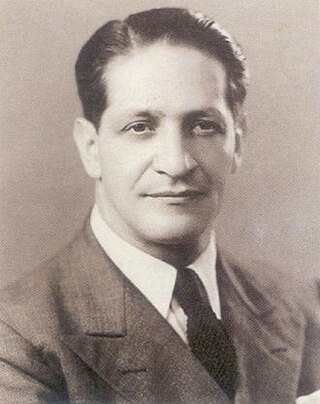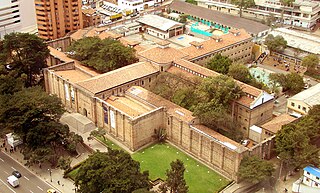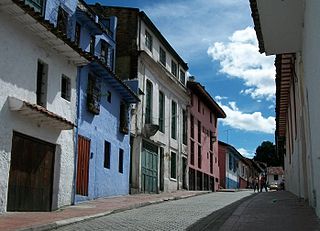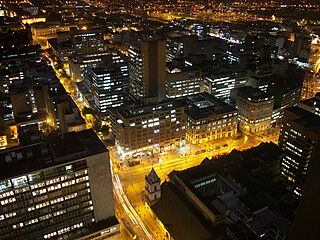
Bogotá, officially Bogotá, Distrito Capital, abbreviated Bogotá, D.C., and formerly known as Santa Fe de Bogotá during the Spanish Colonial period and between 1991 and 2000, is the capital city of Colombia, and one of the largest cities in the world. The city is administered as the Capital District, as well as the capital of, though not part of, the surrounding department of Cundinamarca. Bogotá is a territorial entity of the first order, with the same administrative status as the departments of Colombia. It is the main political, economic, administrative, industrial, cultural, airport, technological, scientific, healthcare and educational center of the country and northern South America.

Jorge Eliécer Gaitán Ayala was a left-wing Colombian politician and charismatic leader of the Liberal Party. He served as the mayor of Bogotá from 1936–37, the national Education Minister from 1940–41, and the Labor Minister from 1943–44. He was assassinated during his second presidential campaign in 1948, setting off the Bogotazo and leading to a violent period of political unrest in Colombian history known as La Violencia. His ideas, known as Gaitanismo, are seen as a form of liberal socialism in Colombia.

The National University of Colombia is a national public research university in Colombia, with general campuses in Bogotá, Medellín, Manizales and Palmira, and satellite campuses in Leticia, San Andrés, Arauca, Tumaco, and La Paz, Cesar. Established in 1867 by an act of the Congress of Colombia, it is one of the largest universities in the country, with more than 53,000 students. The university grants academic degrees and offers 450 academic programmes, including 95 undergraduate degrees, 83 academic specializations, 40 medical specialties, 167 master's degrees, and 65 doctorates. Approximately 44,000 students are enrolled for an undergraduate degree and 8,000 for a postgraduate degree. It is also one of the few universities that employs postdoctorate fellows in the country.

The Museum of Gold is an archaeology museum located in Bogotá, Colombia. It is one of the most visited touristic highlights in the country. The museum receives around 500,000 tourists per year.
The history of Communism in Colombia goes back as far as the 1920s and has its roots in the ideas of the Russian October Revolution. Today guerrilla groups, self-proclaimed communists, state that they want to seize state power in Colombia by violent means, and organizations such as the National Liberation Army (ELN) continue their four decades old war with the United States-backed Colombian government.

El Bogotazo was a massive outbreak of rioting after the assassination in Bogotá, Colombia of Liberal leader and presidential candidate Jorge Eliécer Gaitán on 9 April 1948 during the government of President Mariano Ospina Pérez. The 10-hour riot left much of downtown Bogotá destroyed. The aftershock of Gaitan's murder continued extending through the countryside and escalated a period of violence which had begun eighteen years before, in 1930, and was triggered by the fall of the conservative party from government and the rise of the liberals. The 1946 presidential elections brought the downfall of the liberals allowing conservative Mariano Ospina Pérez to win the presidency. The struggle for power between both again triggered a period in the history of Colombia known as La Violencia that lasted until approximately 1958; the civil conflict that continues to this day originated from that event.

La Violencia was a ten-year civil war in Colombia from 1948 to 1958, between the Colombian Conservative Party and the Colombian Liberal Party, fought mainly in the countryside.

Alonso Neira Martinez was a Colombian sculptor.

Teusaquillo is the 13th locality of Bogotá, capital of Colombia. It is located in the geographic center of the city, to the northwest of downtown Bogotá. This district is inhabited by middle and upper class residents. It is an urbanized locality with several green zones as parks, avenues, and the campus of the National University of Colombia. Most of the heritage buildings and houses of Bogotá are in this locality. It is located on the former site of an indigenous resguardo known as Pueblo Viejo, which existed until the main urbanization phase of the 20th century.

The National Museum of Colombia is the National Museum of Colombia housing collections on its history, art, culture. Located in Bogotá downtown, is the biggest and oldest museum in Colombia. The National Museum of Colombia is a dependency of the Colombian Ministry of Culture.

La Candelaria is the 17th locality of Bogotá, Colombia. A historic neighborhood in the city's downtown, it is the equivalent to the Old City in other cities. The architecture of the old houses, churches and buildings has Spanish Colonial Baroque, and art deco styles. It houses several universities, libraries and museums.

Juan Roa Sierra was a Colombian known for assassinating Colombian Liberal leader and presidential candidate Jorge Eliécer Gaitán on April 9, 1948. After he shot Gaitán three times, mortally wounding him, a mob chased Roa Sierra down and killed him. The assassination of Gaitan triggered El Bogotazo, riots that partially destroyed Bogota and led to La Violencia, a period of violence that lasted until approximately 1958.
Rogelio Salmona was a French Colombian architect. He was noted for his extensive use of red brick in his buildings and for using natural shapes like spirals, radial geometry and curves in his designs. During the latter part of his life, Salmona gained renown thanks to awards like the first prize at the 1986, 1988, and 1990 Colombian Architecture Biennials, and the Alvar Aalto Medal in 2003. His works are highly representative of Colombian architecture at the end of the twentieth century.

Confessing to Laura is a 1991 Colombian drama film directed by Jaime Osorio Gómez. The film is set during El Bogotazo, a violent rioting that erupted in Bogotá after the assassination of presidential candidate Jorge Eliécer Gaitán on 9 April 1948. The story is about an oppressed husband forced by the circumstances to spend the day at his neighbor’s home, a lonely, mature schoolteacher. The film was selected as the Colombian entry for the Best Foreign Language Film at the 64th Academy Awards, but was not accepted as a nominee.

Carrera Séptima, also known as Eduardo Posada Flórez Avenue, is one of the principal transit arteries which crosses the eastern side of Bogotá north and south. It is the most important thoroughfare of the city in the sense of history, culture, economy, and society. Carrera Séptima is bound to the east by the Eastern Hills.

```
Jose Antonio Osorio Lizarazo was a Colombian writer. He was born and raised in Bogota. He graduated from the Colegio San Bartolomé Nacional in 1916. He then went into journalism; by the age of 23, he was already an experienced journalist, working for the daily Mundo al Día. He was known as a sharp observer of Bogota society. Osorio wrote for almost all the newspapers in the capital, usually under his own name but sometimes under the pseudonym El Solitario.
Adriana Marmorek is a Colombian artist, exploring themes of desire through photography, video, installation and sculpture.
Eliécer or Eliecer may refer to:

Gloria Amparo de las Mercedes Gaitán Jaramillo is a Colombian writer, diplomat, and politician. She was a member of the Chamber of Representatives from 1970 to 1974, and served as Colombia's ambassador to Romania in 1982.














